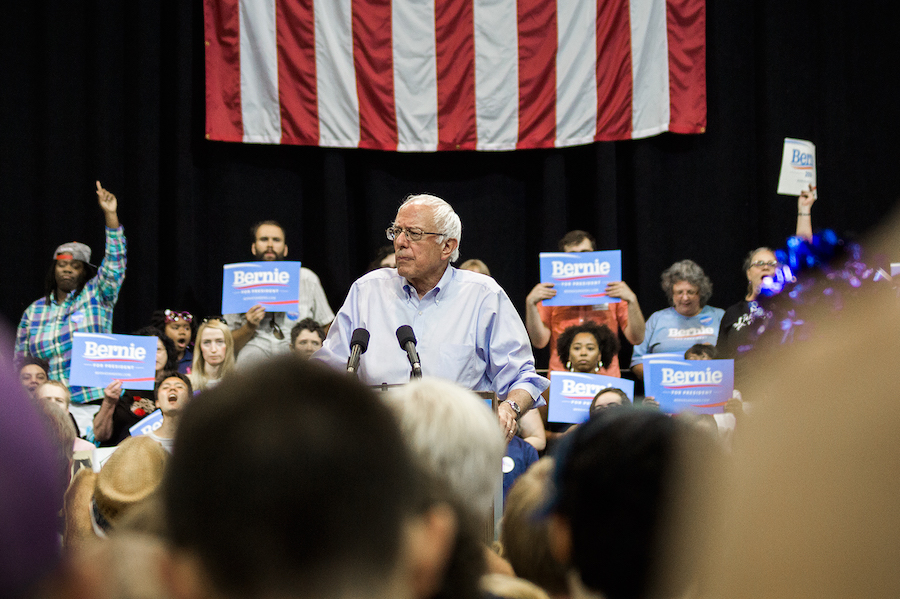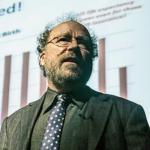Originally posted on Naked Capitalism
Differences between my evaluation of the impact of the Sanders economic program from that of the
Romers reflect different views of the economy, the difference between a static model where national income and employment are largely fixed and a dynamic one where these are shaped by effective demand and are, therefore, susceptible to change in response to economic policy. There are no errors in arithmetic.* It is a fundamental difference in vision that divides our approaches; the same distinction that divided John Maynard Keynes from those he labelled the Classicals in his General Theory of Employment, Interest, and Money.
Followers of Say’s Law, the Classicists believed that the economy always operates at full employment equilibrium except to the extent that price rigidities or failures in the financial system might cause temporary unemployment. For this classical view, the level of output, therefore, is determined exogenously with respect to employment levels; it is set by the supply of factor inputs and technology under the assumptions that the economy will always operate more-or-less at full employment and growth rates are determined exogenously by an exogenous rate of technological progress and an exogenously determined rate of savings and investment.
Under these “Classical” assumptions, policy can do little. It can mildly speed recovery from a shock, but recovery would occur in any case even without government policy, perhaps a little slower. Policy can do little or nothing to raise the long-run growth rate. Because the economy moves naturally towards its full-employment equilibrium, persistently low output must be due to a shock to technology or to the supply of factor inputs rather than to a failure of policy or to a shortfall in demand. Thus, in the Classical view, the appropriate response by policy makers is to adjust downward expectations for economic capacity rather than seek to raise output to a higher level of income and employment.
The Romers critique of my work comes from this old, pre-Keynesian model where the economy tends towards full employment equilibrium and moves to full employment on its own without need for government intervention or stimulus. They can acknowledge the need for government action on occasion, such as after a severe negative shock like the financial crisis of 2007-9. But even then, government stimulus spending is only expected to slightly speed recovery, bringing the return of full employment forward by about 6 months. Without stimulus, the economy will return on its own to full employment at a capacity output set without regard to the level of output and employment reached under the stimulus; and the stimulus itself does nothing to raise output after it is withdrawn. Instead, output levels gravitate towards a full employment level set by factor endowments, by preferences, and by the level of exogenous technology without regard for the level of employment and production. This is a static model in the sense that output is determined outside of the model itself; increasing economic output now has no lasting benefit.
Seen from this perspective a period of prolonged measured slow growth cannot be caused by involuntary unemployment; by a priori assumption, it must be due to a decline in the exogenously determined growth rate in capacity. Like mosquitos on an otherwise delightful summer afternoon, slow growth is unfortunate but there is little that can safely be done about it.
I think that we can find safe ways to enjoy even buggy summers. Instead of the static Classical model, I would use that developed by John Maynard Keynes for periods of slow economic growth in the 1920s (in the United Kingdom) and the 1930s (throughout the world), models extended by him and by his students and colleagues, including Nicholas Kaldor, Joan Robinson and Michael Kalecki, into a general theory of growth. Having observed a period of slow growth similar to what we have experienced in the last six years, and a period of severe recession, Keynes rejected the Classical view and Say’s Law. Instead, he argued that an economy can have a low-employment equilibrium where a lack of effective demand constrains demand, and policy can increase growth by encouraging increased consumption and investment to increase output and employment to full employment. With Kaldor, Kalecki, Robinson, Petrus Verdoorn, and Joseph Schumpeter, he went further to reject the very idea that capacity output is fixed without regard to the past level of employment and production: faster growth promotes faster growth by encouraging investment, greater labor force participation, and more technological innovation with higher productivity growth. Drawing on these theories, I would argue that in the United States today, productivity and the growth rate of capacity can be raised by policies that push the economy, drawing more into the labor force and by increasing investment and productivity.
Curiously enough, even from their static framework, these are ideas that should be familiar to the Romers. Certainly, they accept the idea that periods of prolonged unemployment and underutilization of capacity can lower capacity by discouraging workers and reducing the incentive to invest, to innovate, and to raise productivity. They are quite ready to apply this idea to the United States economy over the last few years, as did the Congressional Budget Office when it applied a sharp downward revision to its estimate of the trend growth rate in output after the Great Recession. We agree that people leave the labor force, investments are deferred, and productivity growth falls because of slow growth. Why not then the contrary? Why not have a period where high employment raises output by drawing more into the labor force, and by upgrading skills, promoting investment, and raising productivity through learning-by-doing? If recession induces a decline in productivity, could a boom raise productivity growth through induced investment in equipment and facilities, and when employers seek to increase the efficiency of their operations to reap profits from expanding sales opportunities? This is a model consistent with some of the giants in the economics profession, including not only Keynes, Kaldor, and Verdoorn, and Schumpeter.
For a time leading up to the current Great Recession, economists were enamored of the Classical models favored by the Romers. In recent years, however, a growing number are taking a new look at models like those developed by Keynes and Kaldor, and are seeing merit in dynamic approaches that recognize the link between output levels and growth rates. Reviewing the state of the discipline after nearly a decade of slow economic growth and high unemployment, Olivier Blanchard, Chief Economist at the IMF, stated that macroeconomics was in an “existential crisis.” Fortunately, he observes,
….a hundred intellectual flowers are blooming. Some are very old flowers: Hyman Minsky’s financial instability hypothesis. Kaldorian models of growth and inequality. Some propositions that would have been considered anathema in the past are being proposed by “serious” economists: … fundamental assumptions are being challenged, for example the clean separation between cycles and trends: Hysteresis is making a comeback. Some of the econometric tools, based on a vision of the world as being stationary around a trend, are being challenged. This is all for the best. Finally, there is a clear swing of the pendulum away from markets towards government intervention….
My report is in the spirit of Blanchard’s openness to new dynamic models. In contrast with the Classical view espoused by the Romers, my model sees a dynamic effect from faster growth that pushes the economy to higher levels of output, employment, and productivity. An economic stimulus not only reduces involuntary unemployment caused by the previous shortfall in effective demand, but it can lead to a higher level of employment, investment, and productivity growth, increasing economic capacity and raising the trend growth rate of income. Rather than dismiss evidence of a growing output gap, as some orthodox macro economists have done by assuming that the United States suffered a great loss of efficiency since 2007, I see an economy at low-employment equilibrium where discouraged workers have abandoned the labor market and firms have had little incentive to innovate or to raise productivity.
In this situation, additional stimulus not only raises output temporarily, but by priming the pump and encouraging additional private spending and investment, it can push the economy upwards towards capacity. And, capacity itself will grow more quickly when higher levels of employment lead more people to look for work, more businesses to invest, and businesses to find new ways to raise productivity to match growing demand. All this will push up the growth rate in capacity. That is why I see lasting effects from a government stimulus.
If the Romers were right that the economy is at full employment at capacity utilization, and capacity utilization grows independently of the level of output, then there could not be a lasting stimulus effect at a fully employed economy. In their model, a stimulus can raise output only temporarily because output depends on capacity and the economy is always at or moving towards capacity. But, if the economy can be stuck at an unemployment equilibrium, if it does not move to a full employment equilibrium, or if a higher employment and output level can trigger a higher growth rate, then a Keynesian-style government stimulus can have lasting effects. Even a one year stimulus can push employment and output to a permanently higher level, and at that higher level it can generate faster growth by pulling more into the labor force and stimulating higher productivity growth. In this Keynes-Kaldor case, with equilibrium unemployment and growth dependent on the level of the output gap, a one year stimulus can lead to permanently higher output both by reducing unemployment and by raising the growth rate of capacity.
In this debate, there are important empirical questions dividing me and the Romers: are we 11% below capacity, as I would estimate, or are we 2-4% below, as the Romers suggest? But the larger theoretical issue goes beyond this: is capacity set, is productivity growth exogenously determined, or are these endogenous with respect to output levels? In short: does capacity rise when the economy expands?
While economists from different perspectives will differ on these fundamental issues, we have experience in the United States that demonstrates the lasting effect of government stimulus spending. Emerging from the depths of the Great Depression, New Deal stimulus spending (including monetary easing) nearly doubled the GDP growth rate from pre-1929 levels to 7% per year, 1933-40, and nearly 10% a year from 1933-44; between the 1929 peak and 1944, output grew to a level 25% higher than it would have been at the pre-1929 growth rate. Active Keynesian policy maintained faster growth rates for the next quarter century as well. From 1947-73, the unemployment rate averaged 4.7% and annual GDP growth averaged 4.0%; output in 1973 was 13% higher than it would have been at earlier growth rates. Only when we abandoned Keynesian policies after 1973 did growth rates fall. From 1973-2014, annual growth has averaged only 2.6%, almost a full percentage point below the pre-1929 rate, while unemployment has risen to 6.5%. Because of the slowing of growth rates after jettisoning Keynesian policies, output in 2007 was almost 30% less than it would have been at the growth rates of the 1947-73 period.
Economic models matter because they guide policy. For a time after World War II, we had effective economic policy which reduced unemployment and raised growth rates. We turned our backs on this success at the suggestion of economists who adopted older, Classical models premised on assumptions of full employment and exogenously determined growth. The Congressional Budget Office is now projecting growth rates of income and employment significantly slower even than those of 1973-2014. To accept that we cannot do better is to give into counsels of hopelessness whose fruits have been economic desolation and depression.
My initial estimates of the effects of the Sanders program may have been optimistic, and I am preparing alternative estimates on “pessimistic” assumptions of the values of the multipliers and the effect of wage growth that give slower growth rates in income and employment. But even on the most pessimistic assumptions, a Keynes-Kaldorian model would suggest that a large government stimulus program like that proposed by Senator Sanders will dramatically raise income and employment and improve the condition of most Americans. Such policies as Senator Sanders proposes have worked in the past to promote growth. We have done better in the past; my work only seeks to show how we can do better again.
______
* Please note There is no “bad math” as described by Justin Wolfers. Differences between my analysis and that of the Romers, or others favored by Wolfers, come from my use of a different economic model. I am open to the possibility that I have made mistakes, perhaps by over- or under-estimating some of the effects that I describe (technically, the choice of parameter values); as a check, I am currently performing sensitivity analysis of my results, for example, with different values of the multipliers.





